HMS Glasgow, the first of eight Type 26 Frigates being built on the Clyde, has reached a major milestone as she successfully entered the water for the first-ever time today.
The ship is at Glenmallan where she was lowered into the water by a semi-submersible barge before being brought back upriver to Glasgow again, this time to BAE’s facility at Scotstoun for fitting out.
BAE Systems said previously:
“Once in position, the float off will involve the base of the barge being slowly submerged over a number of hours until HMS GLASGOW fully enters the water. She will then return to BAE Systems’ Scotstoun shipyard further along the Clyde, where she will undergo the next stages of outfit before test and commissioning.”
Ben Wallace, Secretary of State for Defence, said:
“HMS GLASGOW entering the water for the first time marks a major milestone for the Type 26 programme which supports thousands of highly skilled jobs in Scotland and more across the wider UK supply chain. We’re continuing to invest in the British shipbuilding industry to maintain the Royal Navy’s cutting-edge ability to defend our nation, while strengthening our partnership with allies.”
David Shepherd, Type 26 Programme Director, BAE Systems, said:
“Seeing HMS GLASGOW in the water for the first time will be a proud and exciting moment for the thousands of people involved in this great endeavour. She will soon transfer to our Scotstoun yard in Glasgow where we look forward to installing her complex systems and bringing her to life.”
For those wondering how they moved the ship onto the barge, little wheeled vehicles under the vessel shown below.
The submersible barge was tested last month ahead of the upcoming launch of the new warship.
According to Malin Group, the barge will initially be used to transport and ‘launch’ the Type 26 Frigates being built by BAE Systems for the Royal Navy and then berthed on the Clyde and made available to industry as required, “catalysing further opportunities for the wider supply chain in fields including shipbuilding, civil construction and renewable energy”.
I went along to watch the barge arrive. Here’s the video.
The 137m long 'CD01', a semi-submersible barge operated by Malin Augustea, has arrived at the BAE shipyard in Govan. Type 26 Frigate HMS Glasgow will later be moved onto the barge which will then move to deep water before submerging and allowing HMs Glasgow to float off. pic.twitter.com/aZ5ALff8OJ
— George Allison (@geoallison) September 8, 2022
John MacSween, Managing Director of the Malin Group, said:
“Securing this piece of equipment marks another positive step forward in the reawakening of the shipping and large-scale marine manufacturing industry in Scotland. This versatile asset, based on the West Coast of Scotland, can be used for launching and bringing ships ashore, docking vessels locally or at remote locations as well as being used to relocate large structures around the UK and further afield.
We are delighted to continue our long-standing relationship with the internationally renowned tug and barge owner specialists Augustea, as well as work with Hat-San who are bringing years of shipbuilding experience to the conversion. We are also extremely grateful for the support we have had from Scottish Enterprise in making this project a reality.”
The barge is a joint venture between the Malin Abram and Augustea and, now modified, represents one of the largest in Europe – it can submerge to load vessels and cargo with draughts of up to 12m and over 137m in length.
It will be based on the Clyde between projects.


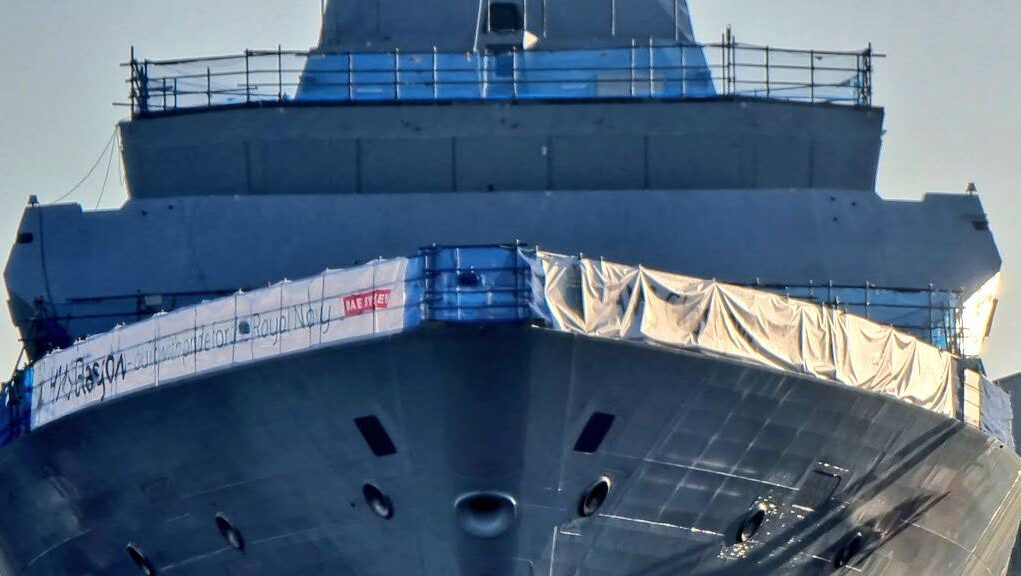

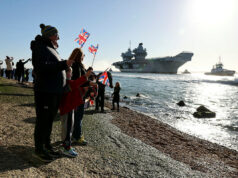


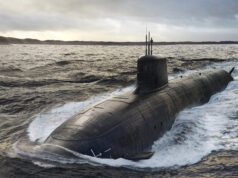
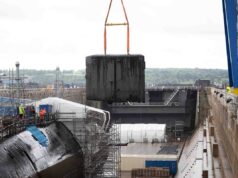
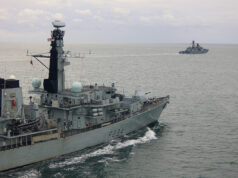
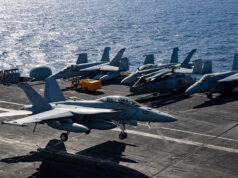

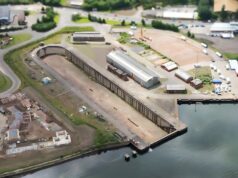
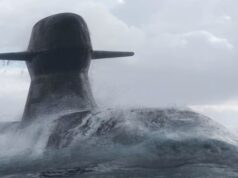

A great looking ship.
Not enough in number for an actual shooting/hot conflict though….
Depends what kind of conflict… If up against China it would act as an alliance. Only the US has a tested unilateral capable war fighting fleet… no one else
Wars are fought as alliance days
…and you would know that, how? Unless you are involved in the design and structure of the vessels you don’t have any idea! If you did then I strongly suspect that you are in breach of TOSA.
Certainly is and look forward to the next batch with HMS Birmingham built on the Clyde
eventually but given the rate of the Clyde’s production of ships we’ll be waiting for a very long time the type 83 will start building before the last T26enters the fleet
My point is, loss of 4 units and that’s half the fleet. Availability means you have 1 or 2 units remaining. Certainly >4 units hit or lost in 1982. Will struggle to counter massed modern VLS attack.
When will it be coming back up the Clyde to Scotstoun? Why was the barge used? Is the Clyde not deep enough for launching at Govan? It certainly was when the Type 45s were launched there.
It’s more controlled launch using the barge. Instead of letting the ship thunder down a ramp slowed down by chains etc. Going to the loch to float the ship off instead of doing it in the river helps as there’s no river flow to deal with and more space etc.
Er’s a big ‘ol girl in ‘er?😀
no way us a ship that bug is a frigate it could easily be a cruiser
With the armament she’s getting she’ll be able to take on all comers.👍
what armament? lets wait and see if it gets anything yet.
FFBNW
Dwarfs the tug
I would suggest the article in the Telegraph is more newsworthy… no funding stream for T32, Royal in trouble, cuts in Army mech. procurement, long list.
The T31 wasn’t funded for many years after its announcement. There are far more pressing concerns than the T32, which even if order now, there’s nowhere to build them.
maybe cancel the 83 for a while and produce a first in clas T26 configured as a destroyer/cruiser save design R&D costs on
T83.
still
Right – they have allocated £12billion for cockups and “R&D”
“About half will be ring-fenced as a reserve in case existing programmes run over budget, and for research and development projects.”
Words fail me
To be fair, I’m not sure that T32 was ever really an immediate prospect, its genesis seems to have been a stream of consciousness from Boris Johnson just before the Queen Elizabeth carrier group deployment set sail. Many of his announcements were never within the envelope of facts or truth, perhaps this is another example.
Personally, I think they’d be better to continue building batch 2 and 3 etc T31’s and incorporate the various design and development iterations as the class is operated.
I could live without the type 32, 5 more type 31’s and some form of ocean going supply vessels able to support drones and UUV’s is probably good enough for MCM. T26 can also embark MCM equipment if we need to take it some where nasty.
Honestly, it flabbergasted me that even the poorest educated person knew he was lying when he opened his mouth; and yet thought he was a great guy. I always thought he was a complete tw@t.
However, T32 is/was meant to be a follow on to T31 that would operate more autonomous platforms and facilitate the transition to a new form of warfighting. Alas, not even a research funding stream.
I assume Babcock and BAE will still invest in developing their version of T32, so their designs are more mature for when the RN decides to invest again.
You’re a glass half full person, aren’t you 😉
whatever the outcome of the T32, the RN needs a high number of the class designed to be produced in a decent amount quickly. emphasis on production time should be a higher priority than the other ships un the design stage
Which article are you talking about? The only one I’ve seen in recent weeks is mostly about bringing forward kit for the army and more Chinooks at the probable expense of more transports.
More chinooks? Are the 50+ they already have not enough? The navy need more helicopters as a priority over more chinooks in my opinion
Another 14 so the article says.
They are replacing the older versions in the UK fleet mate, not increasing the numbers.
You may well be right. The article implies that they increasing the number in the RAF but it has been known for the DT to get things wrong!😪
I can confirm the new Chinooks are replacing the legacy Mk1s we bought back in the 1980’s. Even though the airframe does not have a fatigue life, like a fixed wing aircraft. Doing 40 years of training, peacekeeping and combat operations has been a hard life for these aircraft.
They are requiring more and more structural repairs, which delays the amount of time they are available for tasking. The Mk1s in particular has layered up frames, ie lots of plates etc put together to make a frame. The newer Chinooks use milled one piece frames or frames that use less separate joined together pieces, making them much stiffer. The constant vibration and twisting causes cracks, which need repairing. The newer Chinooks don’t twist as much, due to the stiffer frames.
These new Chinooks are also going to be the fat tank ones. Which means that they not only fly further. But perhaps more importantly they won’t require the internal role fit fuel tanks that take up a lot of pax space. They will also be in-flight refuelable. Though we won’t have anything that can refuel them at the moment.
So basically the thinking is by buying new Chinooks. They are going to be more reliable and therefore have better availability for tasking.
👍👍
Well that all sounds far to sensible for it to be a uk defence program. Surely they want to retire all the old chinooks and order replacement ones 5 years later.
Is this the same 14 chinooks that were announced years ago? David Cameron time perhaps?
Possibly, it was announced publicly around 3 years ago. Though proceedings were happening before that. Unlike other Chinooks we have bought before and similar to the recent AH64E purchase. These are being bought direct from the US Army. As it comes out of one of their big purchase programs, rather than being bought from Boeing. In theory the aircraft should be cheaper. But they won’t come under the extant Boeing support contract. So it remains to be seen how that is going to work, especially as the US Army are the design authority and not Boeing.
No geoff. Replacing older ones like dear old “BN Bravo November” who earned her place in the RAF Musuem for the nation.
Newer are longer ranged, was suggested for carrier use too.
Was announced a few years ago but the order for 14 put on hold due to budget issues.
The Chinook force is one area we are not short, and I believe the squadrons we have ( 7, 18, 27, 28R ) cannot use all the airframes we possess.
As expected then, but again we cannot use all we have? Pilot training?
Hi. Article in the Telegraph on… Thursday??
I think so David , mostly about the army.
looks more like a cornflake box
Very best wishes for the T-26 program going forward. 😊
T26 cruiser more like
Good to see the first of eight in the water and some decent self-defence for her coming aboard in the shape of NSM plus Dragonfire in the years ahead.
Any ideas on how long the fitting-out process takes?
Dragonfire video included. It looks impressive!
https://www.thedefensepost.com/2022/11/10/uk-laser-energy-weapon/
And so does the NSM!
https://www.youtube.com/watch?v=AMowaZ3I90o
https://www.youtube.com/watch?v=1VRn3z4OA6M
Type 26 won’t be getting NSM, she will have FC/ASW instead.
Correct, if it’s ready by 2028 which might not be possible.
Hopefully, it will be!
https://www.navylookout.com/a-guide-to-the-type-26-frigate/
Any videos of the lowering?
Expected to commision 2028, six years to fit out, trials etc. HMS Belfast is about 2 years behind Glasgow.
I miss the traditional launches, gets it over with PDQ. Good to see progress being made.
It seems a long time but must be needed. The trials etc will take a good chunk of that time.
My God how long does it take to build a frigate?
From laid down (or first steel) to fully operational, together with a couple of other recent ship types. All first in class.
HMS Boadsword Type 22 – 4 years 6 months
HMS Norfolk, Type 23 – 6 years
HMS Daring, Type 45 – 7 years 3 months
HMS Forth, B2 River – 4 years 8 months
HMS Venturer, Type 31 (expected) – 6 years
HMS Glasgow, Type 26 (expected) – 11 years 2 months
I might look up some European equivalents later today if I have time.
First FREMM was 5 years 3 months, last FREMM’s a bit less than 4 years.
4 years to build a patrol boat? that’s a disgrace
HMS Forth had some problems with the quality of the superglue used to stick the rivet heads on, so yes, a disgrace. She had to be sent back for rework and retesting after commissioning and the faults discovered.
Comparisons are easily made but the circumstances regarding the speed some projects are delivered are too many and varied.But for a Ship which started construction at pretty much the same time as Glasgow,being a new design,first of class i give you this – https://www.marina.difesa.it/media-cultura/Notiziario-online/Pagine/20190615_varo_Thaon_di_Revel.aspx
A little over 5 years from laying down to operational. Nominally an OPV, but that’s a frigate in all but name, close to a Type 31.
The OPV build was deliberately stalled and slowed to retain the ship builder knowledge on the project so that it would be available for T26 when it started.
It wasnt quite a pork barrel project but very nearly. It was done that way for specific reasons that are now paying dividends with the T26 builds.
on the CLyde? a lifetime
too long by far
My God how long does it take to get two accounts?
Are they going to drydock it to fit the bow sonar or somehow do that while it’s in the water?
I think it’s a drydock job.
T32…a slip up by the PM I reckon, jumped on by defence people to give it more substance.
Surely a batch 2 and 3 T31 is the sensible cost effective way to go? I am sure they can alter the boat bay bits sufficiently to accommodate all the uav’s, uuv’s, XlL-uuauv’s and mini-aauuvuauv’s that will be PILING up on the dock ready to be fitted…
AA
Agreed. Type 32 being a Batch 2 Type 31 was always the logical choice. It works on ship itself cost grounds. Build, maintenance and operation and manpower cost. Training cross decking etc.
or q batch3river class designed to fight
That’s a good idea.
i waas looking at papers surrounding the old type 14 Blackwood’ frigate in particular h.m.s Exmouth which was fitted with a gas turbine, it was a popular and well produced class i visualised ut with modern kit and it looked like a plausible size for theT32.
Although the equipment available at the time was heavy (limbo), the boats only had an armament of a couple or three Bofors 40mm, I think it was also long and thin and may not have the stability mandated for modern vessels. No doubt, as It was a sort of stripped down Type 12 class vessel, it was a good sub hunter for the day.
A Batch 3 River may well tick some boxes for a “Black Swan Sloop-of-war” drone containership. Perhaps the Black Swan was ahead of its time?
Probably a modern Bofors 40mm and sea Ceptor capability is all a batch 3 would need for its auxiliary function.
AA
Silly question but when the Glasgow hits the water is that her official launch date? I do wish that people would stop calling her HMS Glasgow, she has not been commissioned yet so she is not HMS. Until she is commissioned she carries a blue ensign not the white ensign.
I also noticed the articles about T32 etc. I am not to concerned at the moment, all T31s are to be completed by 2028/29 so a follow on T32 could not be started until that time. The same with the Multi Role Support Ship, they will possibly follow on from the Fleet Support Ship construction which will end in the late 2020s. This will give time to look at the development of UAVs, UUVs, etc and the future of the Royal Marines. As long as some money is given to develop and produce construction plans the RN could still see an increase in numbers by 2035. So the future T32 built by Babcock construction start 2029, the T83 by BAE construction start 2033, the MRSS by BMT/H&W construction start 2030. All the RN needs extra is 2-3 LHDs and the future looks good.
Hear, hear. The other thing that bugs me is when journalists talk about “the HMS xxxx”.
You can dream.
This is more of a disaster than most on here seem to realise as the delays are likely to run into the th 2030’s because Hunt has delayed quite a bit of his tax rises / cuts until after the next election – political common sense really. However, if it takes another three or four years to get the finances back into order we are looking at 2027 at the earliest before these big defence programmes ca get underway, if they ever do.
Then there is the question of the engineering industrial capacity. If the ship designs are not sufficiently matured with in a very narrow time slot there will not be enough time to design, order and manufacture long lead items e.g. everything from fridges to radars, missile silos to weapons handling systems. All of then need to be designed to be the requirements of the platform and crews and the designers need to know how much space they have, what shape it is etc… Lots of information will need to flow between the platform designers and system and subsystem designers.
If the design process is not sufficiently mature at the right time the supply chain will start to attrify long before the last of the T26 / T31 are even floated let alone commissioned.
If the last of the T26 are to be delivered in the early 2030’s then the long lead items for the next class are likely to need to be committed to (i.e. design contracts) somewhere in the late 2020’s. We should forget that the ship yards will also be building more than one ship at a time as well. So either the next class is ready to go onto the ‘line’ on time as well or the yards will start to lose the their steel cutting, shaping and welding capabilities.
So I’m not as comfortable with the delay in the T83 / T32 as most on here appear to be. The T32 could be easily replaced with another batch of T31, perhaps with a revised mission bay, but if the T83 is to be a high end AD warship than that needs to get under way now or in the very near future so that the supply chain can gear up to deliver the long lead items on time. Otherwise as the NAO points out costs will inevitably rise as we end up paying BAES and Babcock stupidly high prices to build low end patrol ships just to keep the yards and supply chain sufficiently busy to stay afloat. We will then have to pay extra on top as they struggle to up skill their workforce to deal with the extra complexity of the high end warships. Remember the gapped SSN programme..?
End result, huge cost overruns, late delivery and we set ourselves up for the next debacle… Politicians never learn – idiots. The National Shipping Startegy was designed to prevent the start stop issues within the supply chain as well as at the yards. As an engineer I cannot explain how fed up I am right now. This is setting up the next procurement programmes to be just as over budget and late as the Global Combat Ship / T26 is…
The more I think about it the more exasperated I get. We need more people with technology / science experience in positions of power…
CR
The contract for the second batch of T26 is done. The rate is set, and steel will probably be cut for Birmingham in February. Budget cuts aren’t likely to affect it, and the rate won’t be too slow as the unit price is relatively low. Shephard guessed every 18 months, so let’s go with that. That means steel will be first cut on the last ship, HMS London, start of 2029 for delivery in maybe 2035.
If we look at when steel could be cut for the first Type 83 [at Govan, a reasonable assumption], ignoring any increased capacity following the new build hall, we should probably look to soon after the launch date for HMS Newcastle: steel cut start of 2026, float off maybe mid 2029? That could give a Type 83 operating by 2037, if the lessons of the Type 26 are learned.
I don’t know what the dates are for the assessment phase of the Type 83 following the concept work that started early this year. Delays would be worrying as it means even if we try to close the gap and get a contract sorted by early 2028, we would fail. If there’s to be a gap, perhaps, a slower-build T26 light could be built, with a lower standard of fit out. That should keep most of the UK supply chain going. No big guns, cheap radar, etc, costing £400m ish (today’s money over 2 years), rather than buying overpriced OPVs to replace to B1 Rivers. We should order four cheap OPVs for fisheries protection (~£40-50m) from Appledore.
I hope we find a way to get the MRSS programme back on track, but I wouldn’t feel at all disappointed if the T32 programme was cut after concept. I’d rather we spirally evolved the T31s than went to town on a new design. Add extra “plumbing” for NavyPODS. Make space for more drones, Proteus, ARCIMS, CETUS, etc. Some hand-me-down NSMs, perhaps. Modernise its digital spine. Upgrade the digital twin to allow for system of systems operations. UK radar. Better MTU engines if any are available, etc. Nothing that costs a lot of money.
easy if you can get rid of the dusty old admirals at the admiralty taking up space and what exactly do they do? apart from being quoted on something from time to time
Tony Radakin when 1SL did a lot of that, shifting manpower from shore to ship and cutting a swathe through the brass.
i care not one jot, but there is no way that Glasgow is a frigate. that ship is every unch a destroyer or a cruiser. reconfigured in a few areas there will be no need to design the type 83, are configured type 26 will do the job
In 1877 the Royal Navy reclassified all it’s frigates as “cruisers”. By 1900 the same ended up happening with the Germans too. Could even say that some of theirs ended up as a ship of the line.
In 1975 the USN reclassified it’s frigates as cruisers. A few of those were nuclear powered.
Nothing wrong with calling it a frigate. Or a cruiser. Could also follow the French and say: to hell with it, call everything a frigate!😀
Nooobody follows the French! Anyhoo, anyone know how the Canuks and the Cobbers T26’s are coming along? 🤔
typical french sneaky ideas
1877? were you around back then?
my steaming boots were!
There are records. I think it was an admiralty decree. The ones that got burned are probably the ones in World War II.
There is no way that the type 26 is a frigate, no way.